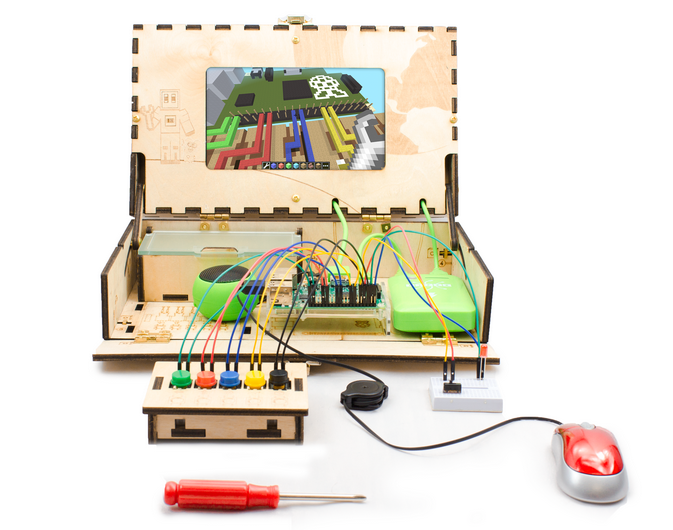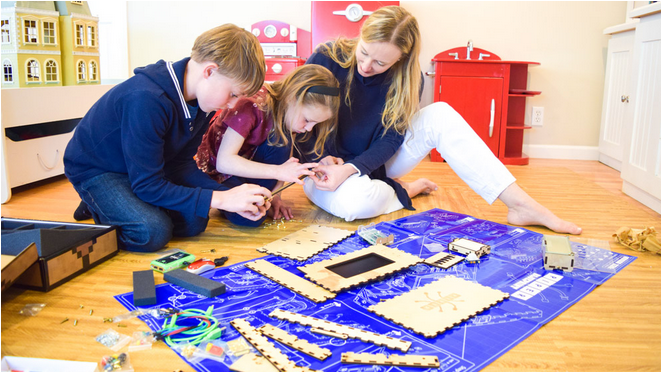Many of us are holding mysteries in our hands …
While research suggests we might even love the supercomputers we call smartphones more than sex, relatively few of us actually know what makes them tick. We love ‘em but don’t understand ‘em.
“Why don’t we know how the technology around us works,” asks Tommy Gibbons, the guy in charge of making customers happy at Piper, a startup that sells kits that allow children to build a real computer and learn science and engineering skills.
Technology can be intimidating, according to Gibbons, if you’re not exposed to it early on. It can be even more challenging to learn and understand as we become adults and categorize ourselves as “nontechnical” people.
That’s why Piper was founded- to get technology into the hands of children as early as possible and in a way that helps them better understand it. Don’t confuse sticking a phone or a tablet in your child’s hands with exposing them to technology — even if they do spend hours fixated on the devices.
“These devices are the new pacifiers,” Gibbons says. Instead of simply parking a child in front of a screen, Piper wanted to create a product that not only offered the enjoyment that comes from consuming what’s on a screen but also the intellectual nutrients associated with understanding how the technology behind the screen works. “You need to know as much about your device as it knows about you,” Gibbons argues.
To make it happen under tight deadline pressure though, Piper would have to pull off a Christmas fulfillment miracle- from a rented storage unit.
A Bunch Of Wooden Parts
The ad on Craigslist and the call out on TaskRabbit was urgent …
Piper was funded on Kickstarter in April 2015. It needed help and it needed it fast if it was to make good on its $280,000 Kickstarter promise to deliver computer kits to more than 1,300 backers by Christmas 2015. The only shot the Piper team had at making the deadline was to do something risky. You see, packing the kits requires special attention and it wasn’t looking as if the manufacturer was going to be able to do it all by Christmas.
“It’s comprised of many wooden parts but how they’re arranged really makes a difference when children open the kit and begin trying to put them together,” Gibbons says.

So Gibbons and the Piper team, which consisted of just four people at the time, had all of the pieces shipped to Los Angeles where the group rented a storage unit and worked side-by-side with the hired help to expedite the packing and fulfillment process.
“It’s a pretty funny story,” Gibbons says. “We really pulled together in that storage unit and fulfilled all of the domestic orders in time for Christmas delivery.”
Here’s what all of those children opened on Christmas morning 2015…
The Piper comes in a kit that allows children to build a real computer from more than one hundred parts and an engineering diagram. It takes about an hour and a half to assemble after which children can use the computer to:
- Build electronics
- Surf the web
- Play games
- Learn to code
“Learning to code isn’t necessarily naturally enticing to children,” Gibbons says. “But we’re following in the tradition of Lincoln Logs and Legos by empowering kids to create something tangible that didn’t exist before and using that to introduce children to beginner programming languages.”

Piper was built for children ages eight to twelve though kids as young as six are using it to develop creative confidence, problem-solving skills, and what the company calls a growth mindset- the belief and confidence that you can continually add to your abilities through exposure to new ideas or skill sets.
What’s a growth mindset and how does an 8-year-old acquire one? Here’s what that looks like in the real world:
- Piper surveyed school children to identify subject matter they feel confident or proficient in
- Survey results revealed children lack confidence or proficiency in computers and electronics
- After the children begin using Piper, the company says student confidence and proficiency levels in those subjects often increases by as much as 20%
“The real benefit is that one day we might create a world full of people with an engineering mindset who aren’t afraid to take things apart and solve problems,” Gibbons says.“These kids gain the confidence they’ve never had before and often wind up joining robotics clubs or building drones because now they’re interested in making technology rather than just consuming it.”
Once the computer is assembled, children can advance through a Raspberry Pi edition of Minecraft, Piper’s story mode to learn physical engineering and electronics, and use their computer to invent things that are brought to life via 3D printers. That wasn’t enough for Piper devotees though…
They wanted even more from a company already inspiring the inventors of tomorrow.
A Woody DIY Feel
You have to work really hard to find something less than glowingly positive to say about Piper and the impact it’s having …
But Gibbons acknowledges the computer’s price ($299) is an issue for some. “We don’t enjoy the price,” Gibbons says. “But we think that over time we’re going to be able to bring the price down.”
We bring up the topic of price only to highlight Piper’s sincere commitment to its mission; the company generously reduces Piper’s price so some of the poorest schools in the United States can offer their students the same opportunities wealthier parents and schools in Silicon Valley offer their children.
“This means everything to us,” Gibbons says proudly. “Schools are on tight budgets and children in lower-income areas should have the same opportunities to learn about technology as children elsewhere.”
It’s no wonder then that the world has fallen in love with Piper, and it’s one of the reasons why Piper has sold thousands of units across the world and experienced 10X year over year sales growth between 2015-2016. “You wouldn’t believe the demand for Piper in countries like Australia, Japan, and Canada,” Gibbons says.”It’s a U.S. product developed in the Bay area but has worldwide appeal.”
To keep up with demand, Piper recently upgraded to Shopify, an enterprise ecommerce platform for high volume merchants who value a platform that can scale on demand. “Shopify has been a great tool for our business,” Gibbons says. “We’ve been with Shopify from day one. Shopify allows us to easily see the location of our sales so we can quickly begin to advertise in parts of the world where we see the best product-market fit.”
Remember, despite everything Piper has to offer customers have told the company they want even more. So Piper relies on Plus’ ability to easily integrate with third-party applications to provide customers with exactly what they want. For instance, Piper uses ReCharge, which allows merchants to offer subscriptions that yield predictable recurring revenue, to provide customers additional parts and components that children can use to add on to their Piper and use to create new things.

“It’s exciting to be able to send customers something every month,” Gibbons says. “The ability to integrate tools like this combined with Shopify’s premium support is a positive factor.”
But Piper begs a question that thus far we’ve left unanswered; why make a computer out of wood? “It’s not designed to be an out-of-the-box beautiful Apple product,” Gibbons says. “We use wood to evoke a do-it-yourself artisan like feeling in children.”
Tesla Seeds
“There’s not a technology company out there specifically for children,” Gibbons laments. Piper plans to change that…
Expect the company to attempt to build a brand that becomes a household name and solidify its position as the computer company for children.

While Gibbons was tight-lipped when asked what new types of technology the company might launch in the future, he did suggest a big announcement would likely come later this year. In the meantime, count on Piper to continue expanding its capabilities and turning the world’s children into creators of technology rather than just consumers of it.
“We’re trying to plant a seed,” Gibbons says. “We understand not everyone is going to grow up and be a hardware engineer at Tesla. We just want to inspire as many children as we can and help them develop the confidence and self-reliance necessary to solve problems regardless of what they grow up to do.”
Read more
- The Multi-Channel Menace: Young & Reckless, YouTube, & Mastering Customer Engagement
- How a Seller of Outlandish Party Costumes Optimized Its Warehouse to Grow 400% & Compete With Amazon
- Mava Sports Buffed Up, Leaned Out, and Branded its Ecommerce Enterprise
- Why Two Guys With No Kids Started a Luxury Baby Essentials Brand Moms Are Raving About
- How This Lifeguard is Disrupting Women’s Athletic Swimwear
- How Memobottle Reimagined the Water Bottle & Sparked a Movement That Crashed the Oscars
- How Bohemia 4X’d Sales After Migrating & Supports the Survival of Artisan Crafts
- How a Broke Fitness Trainer Accidentally Created a Multimillion-Dollar Business Without Advertising
- How Whimsy Rose Uses the Shopify Plus API to Co-Create Personalized Fashion With Customers On Demand
- How Leesa is Disrupting the Mattress Industry by Shipping Beds in Boxes & Making Richard Branson Proud


